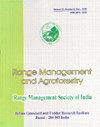Quality, productivity and profitability of diversified fodder-based cropping systems for year-round fodder production in Indo-gangetic plains of India
IF 0.8
4区 农林科学
Q3 AGRONOMY
引用次数: 0
Abstract
An experiment was conducted during two consecutive years of 2017-18 and 2018-19 at National Dairy Research Institute, Karnal under randomized complete block design (RCBD) with three replications. This study aimed to evaluate the performance of eight fodder-based cropping systems (CS) in Indo-gangetic plain region (IGP) viz., sole napier bajra hybrid (CS ), sole guinea grass (CS ), napier bajra hybrid + cowpea (Kharif)/ 1 2 berseem (Rabi) (CS ), guinea grass + cowpea (Kharif)/ oats (Rabi) (CS ), multicut sorghum-berseem (Rabi) 3 4 (CS ), cowpea-maize-oats (CS ), baby corn-cowpea-chinese cabbage (Rabi) (CS ), summer moong–multicut 5 6 7 sorghum–ryegrass (Rabi) (CS ). The results revealed that selection of the crops in different cropping systems 8 significantly influenced green fodder yield and fodder quality. Among various fodder base cropping systems, NBH + cowpea/ berseem system was recorded with significantly higher green fodder (177 t/ha/year) and dry fodder (31.5 t/ha/year) yields and also fodder quality attributes. The highest crude protein yield (40.7 q/ha/year) was also recorded in NBH + cowpea/ berseem intercropping system. In terms of economics, the highest gross and net returns were obtained from baby corn-cowpea-chinese cabbage (Rs 3.15 and 2.40 lakh/ha/year, respectively), closely followed by NBH + cowpea/ berseem (Rs 2.74 and 2.15 lakh/ha/year, respectively). To ensure the year-round availability of quality fodder for dairy-based farmers, cultivation of the NBH + cowpea/ berseem cropping system proved to be a viable option.印度恒河平原全年饲料生产的多样化饲料种植系统的质量、生产力和盈利能力
试验于2017-18年和2018-19年在印度卡纳尔国家乳业研究所连续两年采用随机完全区组设计(RCBD)进行,共3个重复。本研究旨在评估八fodder-based种植系统的性能(CS)在恒河平原地区(显卡)即,鞋底纳皮尔珍珠粟混合(CS),唯一的羊草(CS),纳皮尔珍珠粟混合+豇豆(雨季)/ 1 2一种苜蓿(拉比)(CS)、羊草+豇豆(雨季)/燕麦(拉比)(CS), multicut sorghum-berseem(拉比)3 4 (CS), cowpea-maize-oats (CS),婴儿corn-cowpea-chinese卷心菜(拉比)(CS),夏天moong-multicut 5 6 7 sorghum-ryegrass(拉比)(CS)。结果表明,不同种植制度下作物的选择对青饲料产量和饲料品质有显著影响。在各种饲料基础种植体系中,NBH +豇豆/白豆角种植体系青饲料产量(177 t/ha/年)和干饲料产量(31.5 t/ha/年)显著提高,饲料品质指标也显著提高。NBH +豇豆/蚕豆间作体系的粗蛋白质产量最高(40.7 q/ha/年)。在经济方面,玉米-豇豆-白菜的总收益和净收益最高(分别为3.15和2.4万卢比/公顷/年),紧随其后的是NBH +豇豆/ berseem(分别为2.74和21.5万卢比/公顷/年)。为了确保以奶牛为基础的农民全年获得优质饲料,种植NBH +豇豆/贝贝种植系统被证明是一个可行的选择。
本文章由计算机程序翻译,如有差异,请以英文原文为准。
求助全文
约1分钟内获得全文
求助全文
来源期刊

Range Management and Agroforestry
AGRONOMY-
CiteScore
1.50
自引率
62.50%
发文量
25
审稿时长
>12 weeks
期刊介绍:
The Society has been established with the following objectives:
1. To advance the cause of research activity in all aspects of rangelands and to encourage and promote the studies on rangeland, wasteland ecosystems and agroforestry.
2. To provide facilities for seminars and conferences to rangeland researchers, development workers and farmers and to encourage close cooperation with organizations having related aims and interests.
3. To disseminate the knowledge of scientific agriculture and technology for forage and rangeland production, improvement and management.
 求助内容:
求助内容: 应助结果提醒方式:
应助结果提醒方式:


